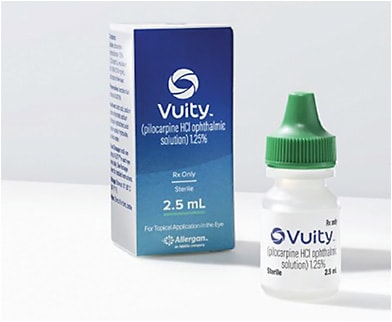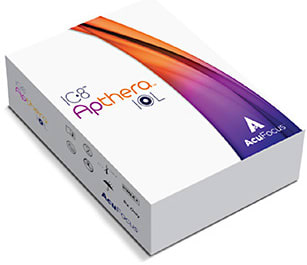Small aperture optics are a welcomed addition to our presbyopia-correction toolbox because they provide increased depth of focus. Specifically, small aperture optics filter out unfocused and aberrated peripheral light, enabling organized, central light rays to focus onto the retina. The result is increased depth of focus. That said, if the pupil is much less than 1 mm, side effects, such as loss of contrast, start to occur. Conversely, if the aperture is much larger than 2.5 mm, minimal depth of focus ensues. Thus, the small aperture effect must extend the depth of focus equally on both sides of the point of best focus to create optimal performance.1
A caveat: Optical clarity is imperative for achieving quality vision with small aperture optics. Because light is channeled through the central part of the cornea, an impairment in the visual axis will degrade the small aperture’s performance. As a result, conditions, such as corneal haze, dry eye disease, cataract, and vitreous opacities, must be addressed prior to prescribing this form of presbyopia correction.
Pharmaceuticals
The FDA-approved eye drop, Vuity (pilocarpine hydrochloride ophthalmic solution 1.25%, AbbVie) constricts the pupil, enhancing near and intermediate vision in roughly 15 minutes, and lasts up to 6 hours with once daily dosing, according to its manufacturer, AbbVie.
I have found that the drop works well for young, phakic individuals who have some residual, natural accommodation, and no other ocular pathology. I have noticed that latent hyperopes who have a prescription of +1.00 D or + 1.50 D can achieve a boost to their vision with the drops, but they may not have complete independence from reading glasses.
The potential side effects of Vuity are brow ache and “dim” vision. Also, there are reports that pilocarpine may exacerbate vitreous detachment, which may lead to retinal tear and/or other vitreoretinal traction sequalae.2
Other pharmaceuticals, such as Brimochol (Visus Therapeutics), CSF-1 (Orasis), Dioptin UNR844-Chloride (Novartis), LNZ100/LNZ101 (Lenz Therapeutics), and Microline (Eyenovia) are in the pipeline. (See bit.ly/3Wau5NB for background information on each.)


IOL
The IC-8 Apthera IOL (developed by AcuFocus, now owned by Bausch + Lomb), is an FDA-approved non-toric, small aperture IOL that provides extended depth-of-focus vision.
The small aperture IOL is intended for unilateral implantation in patients who have up to 1.5 D of corneal astigmatism. Candidates for this option should have no pre-existing condition, such as macular pathology, significant visual field loss, significant ocular surface diseases, or any other conditions that may affect the central visual pathway that may make them prone to requiring close monitoring of the posterior segment. That said, macular OCT to visualize the posterior segment can be done through the small aperture. It is also possible to do surgery around the opaque ring. In my FDA study experience, 2 patients implanted with this IOL later had vitrectomies performed without incident.
Small Aperture Extends Depth of Focus1
- Refraction determines the point of best focus
- A small aperture improves depth of focus equally on either side of the point of best focus

Mean Binocular Uncorrected Visual Acuities3
- Small aperture IOL subjects achieved and maintained excellent binocular far and intermediate uncorrected VA (-0.06 for far, 0.04 for intermediate) and good near visual acuity (0.16 for near)

The IC-8 Apthera IOL is indicated for implantation in the non-dominant eye, along with a monofocal or monofocal toric IOL in the other eye, according to its manufacturer, Bausch + Lomb. With binocularity, most patients see better than 20/20 distance, better than 20/25 intermediate, and better than 20/30 up close.3 Additionally, binocular contrast sensitivity in the IC-8 Apthera eye mirrors the monocular contrast performance of the fellow monofocal IOL–treated eye. Patients can achieve about 3.00 D of continuous binocular depth of focus with the small aperture IOL.3
In both US and international studies, IC-8 Apthera IOL patients reported low-level visual symptoms,3 so it’s important to counsel patients that they may experience glare, halo, or other nighttime vision effects.
Given the IOL’s features, 1 off-label use could be for complex corneas, such as those that have irregular astigmatism, and those that have undergone radial keratotomy or surgical trauma. I have found that such patients can often gain 2, 3, or 4 lines of vision with a pinhole occluder, as it blocks the peripheral aberrated light. Additionally, the literature supports the use of a small aperture IOL in such cases.4-6
Another off-label use could be using the IC-8 Apthera IOL followed by topography-guided photorefractive keratectomy with simultaneous corneal cross-linking. Specifically, 1 retrospective case series (4 eyes) described this approach, and the investigators reported that patients achieved satisfactory refractive outcomes and rigid gas permeable contact lens independence.4
How Far It's Come
In the late 1990s before everyone had a camera at their fingertips, the simple disposable pinhole-style camera provided good pictures across a full range of focus, including distance, intermediate, and near vision. Today, ophthalmologists have 2 small aperture optic options to choose from for their presbyopic patients. CP
References:
- Vukich JA, Durrie DS, Pepose JS. Evaluation of the small-aperture intracorneal inlay: three-year results from the cohort of the US Food and Drug Administration clinical trial. J Cataract Refract Surg. 2018;44(5):541-556.
- Michalak S, Mruthyunjaya P, Rahimy E. Vitreoretinal views on vuity: choose and monitor patients carefully. Retinal Physician. 2022;19(6):44-45.
- Dick HB, Piovella M, Vukich J, et al. Prospective multicenter trial of a small-aperture intraocular lens in cataract surgery. J Cataract Refract Surg. 2017;43(7):956-968.
- Northey LC, Holland SP, Lin DTC, Moloney G. New treatment algorithm for keratoconus and cataract: small-aperture IOL insertion with sequential topography-guided photorefractive keratectomy and simultaneous accelerated corneal crosslinking. J Cataract Refract Surg. 2021;47(11):1411-1416.
- Shajari M, Mackert MJ, Langer J, et al. Safety and efficacy of a small-aperture capsular bag-fixated intraocular lens in eyes with severe corneal irregularities. J Cataract Refract Surg. 2020;46(2):188-192.
- Martínez CE, Applegate RA, Klyce SD, et al. Effect of pupillary dilation on corneal optical aberrations after photorefractive keratectomy. Arch Ophthalmol. 1998;116(8):1053-1062.









